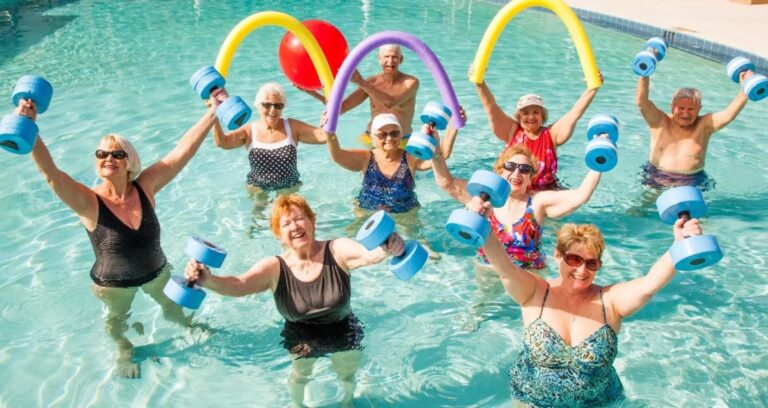As we age, maintaining an active lifestyle becomes increasingly important for our physical and mental health. Regular exercise can help seniors enhance their quality of life, improve mobility, and reduce the risk of chronic diseases. However, safety is paramount when it comes to physical activity for older adults. Choosing the right sports and exercises can help prevent injuries while promoting overall well-being. In this article, we will explore five safe sports for seniors that not only encourage fitness but also provide social interaction and enjoyment.
The Importance of Staying Active as We Age
Physical activity offers numerous benefits for seniors, including:
- Improved Physical Health: Regular exercise can help manage weight, reduce blood pressure, and lower the risk of chronic conditions such as heart disease and diabetes.
- Enhanced Mental Health: Physical activity releases endorphins, which can alleviate symptoms of anxiety and depression, improving mood and cognitive function.
- Increased Mobility and Flexibility: Staying active helps maintain joint health and flexibility, which is crucial for performing daily tasks and maintaining independence.
- Social Engagement: Participating in sports or group activities fosters social connections, reducing feelings of loneliness and isolation.
1. Walking
Overview
Walking is one of the simplest and most accessible forms of exercise for seniors. It requires no special equipment, can be done almost anywhere, and is easy to incorporate into daily routines.
Benefits
- Low Impact: Walking is gentle on the joints, making it suitable for older adults.
- Cardiovascular Health: Regular walking helps strengthen the heart and improve circulation.
- Weight Management: It aids in maintaining a healthy weight.
- Social Opportunities: Walking can be a social activity, whether joining a walking group or strolling with friends or family.
Tips for Safe Walking
- Wear Proper Footwear: Supportive shoes with good cushioning can prevent foot and ankle injuries.
- Start Slow: Begin with short distances and gradually increase as fitness improves.
- Choose Safe Routes: Opt for flat, well-lit, and paved paths to minimize the risk of tripping or falling.
- Use Walking Aids if Needed: Consider using a cane or walker for added stability.
2. Swimming
Overview
Swimming is an excellent full-body workout that is easy on the joints. It provides resistance training and cardiovascular benefits while minimizing the risk of injury.
Benefits
- Joint-Friendly: The buoyancy of water reduces strain on the joints, making it ideal for seniors with arthritis or mobility issues.
- Muscle Strengthening: Swimming engages multiple muscle groups, enhancing strength and endurance.
- Improved Flexibility: The range of motion required in swimming strokes helps maintain flexibility.
- Stress Relief: The soothing nature of water can reduce stress and promote relaxation.
Tips for Safe Swimming
- Take Swimming Classes: Beginners should consider enrolling in swimming lessons to improve technique and confidence.
- Use Pool Aids: Floating devices or pool noodles can provide extra support for those who are less confident in the water.
- Warm-Up and Cool Down: Incorporate gentle stretches before and after swimming to prevent muscle strain.
- Stay Hydrated: Drink water before and after swimming to stay hydrated, even if you’re in the water.
3. Yoga
Overview
Yoga combines physical postures, breathing exercises, and meditation, making it a holistic approach to fitness. It is highly adaptable to different fitness levels and can be practiced in various settings.
Benefits
- Improved Balance: Yoga enhances balance and coordination, reducing the risk of falls.
- Increased Flexibility: Regular practice increases flexibility, which is essential for maintaining mobility as we age.
- Stress Reduction: The focus on breathing and mindfulness promotes relaxation and mental clarity.
- Strength Building: Many yoga poses help build strength, particularly in the core and lower body.
Tips for Safe Yoga Practice
- Choose Gentle Classes: Look for beginner or senior-focused classes that emphasize gentle movements.
- Use Props: Incorporate blocks, straps, or chairs to modify poses and ensure comfort.
- Listen to Your Body: Pay attention to your body’s signals and avoid pushing into pain.
- Practice with a Qualified Instructor: A knowledgeable instructor can provide guidance on proper alignment and modifications.
4. Cycling
Overview
Cycling is a fun and low-impact aerobic exercise that can be enjoyed outdoors or on a stationary bike. It promotes cardiovascular health and strengthens leg muscles.
Benefits
- Low Impact: Like swimming, cycling is gentle on the joints, making it suitable for seniors.
- Cardiovascular Fitness: Regular cycling improves heart health and endurance.
- Flexibility and Mobility: Cycling helps maintain joint flexibility, particularly in the hips and knees.
- Mental Well-Being: Riding outdoors can boost mood and provide a sense of freedom and adventure.
Tips for Safe Cycling
- Choose the Right Bike: Consider a comfortable bike with an adjustable seat. Recumbent bikes are also an excellent option for added support.
- Wear a Helmet: Always wear a helmet to protect against head injuries.
- Start on Flat Terrain: Begin with flat paths before progressing to more challenging routes.
- Stay Visible: Use lights and reflective gear if cycling in low-light conditions.
5. Tai Chi
Overview
Tai Chi is a gentle martial art focusing on slow, flowing movements and deep breathing. It is often described as “meditation in motion,” making it suitable for seniors seeking a low-impact exercise.
Benefits
- Improved Balance: The slow, controlled movements enhance balance and coordination, reducing fall risk.
- Stress Relief: Tai Chi promotes relaxation and mindfulness, helping to alleviate stress.
- Joint Health: The gentle movements can help maintain joint flexibility and reduce stiffness.
- Cognitive Benefits: Practicing Tai Chi can enhance mental clarity and concentration.
Tips for Safe Tai Chi Practice
- Take a Class: Joining a Tai Chi class led by a qualified instructor can provide structure and guidance.
- Practice in a Quiet Environment: Choose a calm space free from distractions to enhance focus and relaxation.
- Wear Comfortable Clothing: Loose-fitting clothing allows for a full range of motion.
- Stay Consistent: Regular practice is key to reaping the benefits of Tai Chi.
Conclusion
Staying active is essential for seniors and older adults to maintain physical health, mental well-being, and overall quality of life. The five sports discussed—walking, swimming, yoga, cycling, and Tai Chi—are not only safe but also enjoyable, allowing older adults to remain engaged and active.
By choosing activities that suit their interests and fitness levels, seniors can enhance their physical capabilities while fostering social connections and personal growth. Remember to consult with a healthcare provider before starting any new exercise program, especially if there are existing health concerns.
With the right approach and a commitment to staying active, older adults can lead vibrant, fulfilling lives, embracing the joys of movement and connection. So, lace up your shoes, grab your swim gear, or roll out your yoga mat, and take the first step toward a healthier, more active lifestyle!

